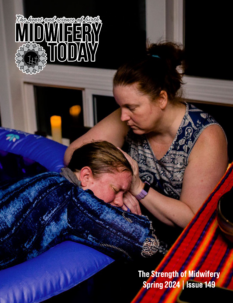
Monet Moutrie—monetnicole.com
Outside the Evidence: Births Missing from the Research
Editor’s note: This article first appeared in Midwifery Today, Issue 117, Spring 2016.
Subscribe to Midwifery Today Magazine
I once worked as a midwife at a large academic medical center. There were private obstetricians, maternal fetal medicine doctors, a gaggle of residents, physician assistants, medical students and midwives sharing a massive labor and delivery unit. We rounded and signed out incessantly each day (there were a lot of people to communicate with), and each week we attended grand rounds, tracing rounds and journal club, all to ensure that every aspect of our care was in keeping with the latest medical evidence.
We worshipped the evidence. From the evidence, our managers made protocols for every scenario. I never read the protocols, but it wasn’t necessary. I was acculturated to the rules at every signout when I’d be asked my plan, and the correct answer was always eventually, “If she hasn’t changed in two hours, start Pitocin.” It seemed that if we followed the protocols, we could manage our risk into tidy little percentage points. When bad things happened, we suspected the practitioners, ourselves included, of infidelity to our holy texts. Every patient, every labor and every shoulder dystocia, hemorrhage and case of chorioamnionitis supported our belief system. The evidence reported reality and our reality reflected the evidence.
A few years later, my husband got a job elsewhere and I left that medical center. I joined another midwifery practice at a small rural hospital. We had home call, so I attended births alone in an eerily quiet unit, while my backup OBs, the OR crew, nurse anesthetists and pediatricians slept at home in their beds.
Of course, then all sorts of strange things started to happen.
All of the high level medical evidence is flawed because it only reflects what happens at institutions that are big enough to do research. I’d like to call this institutional bias or academic bias, but those titles are both taken by other concepts. For lack of a better term, let’s call it research hospital bias.
I attended 28 births before anyone needed a c-section. Women gave birth after six hours of natural pushing and they didn’t have horrible shoulder dystocias. The great majority had compound presentations that I’d never seen before. They would have been whisked to the operating room after three hours at my old hospital. A primip arrived with the breech on the perineum and I delivered her 7 lb 7 oz baby as easily as any vertex baby, without needing so much as a stitch. Women went into labor after 6, 10, 24 and 48 hours after breaking their waters without needing any Pitocin or getting infected.
I’m sure the zealots at my prior institution would attribute the discrepancy in the outcomes to different populations. It’s true that aside from pervasive poverty in both places, the demographics are completely different. But in my new hospital, I have a much wider scope and I care for women with diabetes and those who are morbidly obese; these kinds of moms used to “risk out” of my previous midwifery care. Some of the variation is just plain numbers. In the city hospital, hundreds of patients passed through our doors and our collective consciousness, and in my rural hospital, it could take months to see the same number of cases. Still, I think something bigger is at play.
My small hospital has no institutional review board, no faculty investigators and no ambitions other than to provide excellent care to the people of the community. It would take years to get a sample size large enough to show statistical significance of anything. Everything we do is different and none of it can be captured by the literature. All of the high level medical evidence is flawed because it only reflects what happens at institutions that are big enough to do research. I’d like to call this institutional bias or academic bias, but those titles are both taken by other concepts. For lack of a better term, let’s call it research hospital bias.
Research hospitals cannot quantify the number of prenatal visits with the same provider it takes to know a woman’s face well enough to be able to detect when they look “off.” They can’t capture the influence of small-town life, of whether or not it matters if you bump into a noncompliant patient in the grocery store and get her back in for NSTs. Researchers will never know what happens when there is only one primip in early labor and there are two nurses and one midwife to help her, who are by her side every second to soothe her every fear. It cannot measure what it means when we ease her into the tub and she relaxes and opens from two centimeters to ten in three hours.
There are places that can systematically review, double-blind, randomize and control. There are other places where the nurse who spent her entire shift rubbing a woman’s back was also there when that woman was born; this same nurse is the source of such unimaginable comfort and so we all understand when the new mother sighs, “I never could have done it without you.”
The body of evidence supporting midwifery care is growing all of the time. Still, medical evidence is not the holy grail I once thought it was. While modern midwifery practice incorporates evidence, it still respects the ancient knowledge of birth. Historically, this knowledge has been the target of skepticism and derision from the medical establishment, which was convinced that their forceps, Friedman curves, episiotomies and cord clamping were the best innovations science had to offer. Even as the medical evidence catches up with what midwifery knowledge has always known, it will never be complete. The elements that make research feasible—namely large patient volume and institutional structures, boards and salaries that support research—are only available in a subset of places where births happen. The phenomena that occur at dawn, in dark, sweaty, grunting intimacy, will never find their way to journal pages. These things will remain the domain of birth story secrets, passed woman to woman and midwife to midwife.


















